


Vincent van Gogh
1853 – 1890
The image we have of artists today stems from the dramatic life of Vincent van Gogh. It is a romanticized image that only rarely occurs among artists. Van Gogh was a tormented person from an early age, with a hot-tempered and restless character, convinced that everyone was against him. Everyone except his brother Theo who supported him until his death and gave him money. Van Gogh was a heavy smoker and because of his poor life and therefore poor nutrition, his health was downright bad. Already in his youth he suffered from depression which may indicate that he suffered from a mental illness.
For Van Gogh it was quite a quest to eventually become an artist on the advice of his brother Theo. He tried to work as a clerk at the renowned art dealer Goupil & Cie, was a lay preacher and even passed doors as a door-to-door salesman of Bibles. He didn’t like anything, and no one wanted to keep him employed.
Even though he tried to follow a classical art education at the art academies of Antwerp and Brussels several times, he did not finish anything because of his impetuous character and further developed himself as self-taught. In the years that he worked at Goupil & Cie, in The Hague, London, and Paris, he seized the opportunity to go to the museums in those cities.
It was not before the last four years of his short life, he became only 37, when he made a large part of his paintings with a feverish work drive. Especially during the time that he lived in Arles in the Yellow House, as he called it, numerous famous paintings have arisen. Starry Night over the Rhȏne (1888), The Starry Night (1889), Café Terrace at Night (1888), and Wheatfield with Crows (1890) are paintings in which Van Gogh displayed his admiration for the light and colours of the south of France with great élan.
His work drive is not only expressed in the many paintings but also in his technique. The wild thick brushstrokes and at the same time regularly placed next to each other, give a dynamic to the work that until then had not been used before. Van Gogh not only uses the colours that match the region – yellow, blue, and green – but also reflects the light of the sun and the stars through the way he paints it in circular movements that make the sizzling palpable. In a letter to his brother Theo, Van Gogh wrote about this:
“…under a sulphur-coloured sun, under an air of pure cobalt. The pattern is extremely difficult! But that is exactly the reason why I want to master it. For it is awesome, those yellow houses in the sun and then the incomparable brightness of the blue.”

Vincent van Gogh, Starry Night over the Rhȏne, 1888, oil on canvas, 72 x 92 cm. Collection Musée d’Orsay, Paris

Vincent van Gogh, The Starry Night, 1889, oil on canvas, 74 x 92 cm. Collection Museum of Modern Art, New York

Vincent van Gogh, Cornfield with Crows, 1890, oil on canvas, 50.5 x 103 cm. Collection Van Gogh Museum, Amsterdam (Vincent van Gogh Foundation)

Vincent van Gogh, Café terrace at night (Place du Forum), 1888, oil on canvas, 80.7 x 65.3 cm. Collection Kröller-Müller Museum, Otterlo
